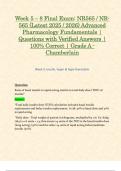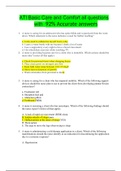Exam (elaborations)
Week 5 – 8 Final Exam: NR565 / NR-565 (Latest 2025 / 2026) Advanced Pharmacology Fundamentals | Questions with Verified Answers | 100% Correct | Grade A - Chamberlain
- Course
- NR 565 (NR565)
- Institution
- Chamberlain College Of Nursing
Week 5 – 8 Final Exam: NR565 / NR-565 (Latest 2025 / 2026) Advanced Pharmacology Fundamentals | Questions with Verified Answers | 100% Correct | Grade A - Chamberlain Week 5: insulin, hyper & hypo thyroidism Question: Ratio of basal insulin to rapid-acting insulin in total daily dose (...
[Show more]




